

Yang–Mills theory. Yang–Mills theory is a gauge theory based on the SU(N) group, or more generally any compact, semi-simple Lie group.
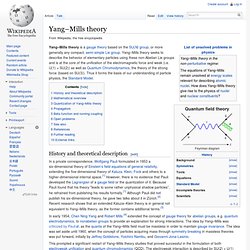
Yang–Mills theory seeks to describe the behavior of elementary particles using these non-Abelian Lie groups and is at the core of the unification of the electromagnetic force and weak (i.e. U(1) × SU(2)) as well as Quantum Chromodynamics, the theory of the strong force (based on SU(3)). Thus it forms the basis of our understanding of particle physics, the Standard Model. History and theoretical description[edit] In a private correspondence, Wolfgang Pauli formulated in 1953 a six-dimensional theory of Einstein's field equations of general relativity, extending the five-dimensional theory of Kaluza, Klein, Fock and others to a higher-dimensional internal space.[1] However, there is no evidence that Pauli developed the Lagrangian of a gauge field or the quantization of it. Mathematical overview[edit] and the covariant derivative defined as The relation Putting since .
A source . . Quantum electrodynamics. In particle physics, quantum electrodynamics (QED) is the relativistic quantum field theory of electrodynamics.
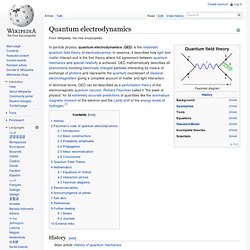
In essence, it describes how light and matter interact and is the first theory where full agreement between quantum mechanics and special relativity is achieved. QED mathematically describes all phenomena involving electrically charged particles interacting by means of exchange of photons and represents the quantum counterpart of classical electromagnetism giving a complete account of matter and light interaction. History[edit] The first formulation of a quantum theory describing radiation and matter interaction is attributed to British scientist Paul Dirac, who (during the 1920s) was first able to compute the coefficient of spontaneous emission of an atom.[2]
Quantum chromodynamics. In theoretical physics, quantum chromodynamics (QCD) is a theory of strong interactions, a fundamental force describing the interactions between quarks and gluons which make up hadrons such as the proton, neutron and pion.
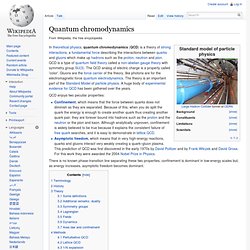
QCD is a type of quantum field theory called a non-abelian gauge theory with symmetry group SU(3). Higgs mechanism. In particle physics, the Higgs mechanism is essential to explain the generation mechanism of the property "mass" for gauge bosons.
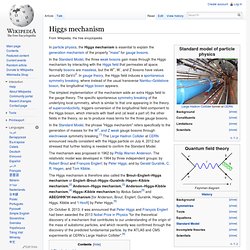
In the Standard Model, the three weak bosons gain mass through the Higgs mechanism by interacting with the Higgs field that permeates all space. Normally bosons are massless, but the W+, W-, and Z bosons have values around 80 GeV/c2. In gauge theory, the Higgs field induces a spontaneous symmetry breaking, where instead of the usual transverse Nambu–Goldstone boson, the longitudinal Higgs boson appears. Electroweak interaction. In particle physics, the electroweak interaction is the unified description of two of the four known fundamental interactions of nature: electromagnetism and the weak interaction.
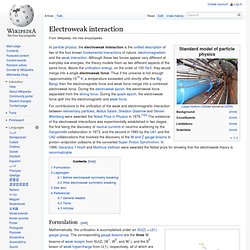
Although these two forces appear very different at everyday low energies, the theory models them as two different aspects of the same force. Above the unification energy, on the order of 100 GeV, they would merge into a single electroweak force. Thus if the universe is hot enough (approximately 1015 K, a temperature exceeded until shortly after the Big Bang) then the electromagnetic force and weak force merge into a combined electroweak force. Standard Model. The Standard Model of particle physics is a theory concerning the electromagnetic, weak, and strong nuclear interactions, as well as classifying all the subatomic particles known.
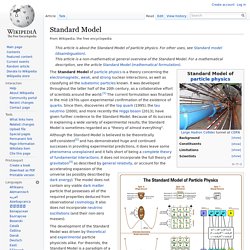
It was developed throughout the latter half of the 20th century, as a collaborative effort of scientists around the world.[1] The current formulation was finalized in the mid-1970s upon experimental confirmation of the existence of quarks. Since then, discoveries of the top quark (1995), the tau neutrino (2000), and more recently the Higgs boson (2013), have given further credence to the Standard Model. Because of its success in explaining a wide variety of experimental results, the Standard Model is sometimes regarded as a "theory of almost everything".
Historical background[edit] The Higgs mechanism is believed to give rise to the masses of all the elementary particles in the Standard Model. Overview[edit] Particle content[edit] Fermions[edit] Gauge bosons[edit] Higgs boson[edit] Main article: Higgs boson E.S.